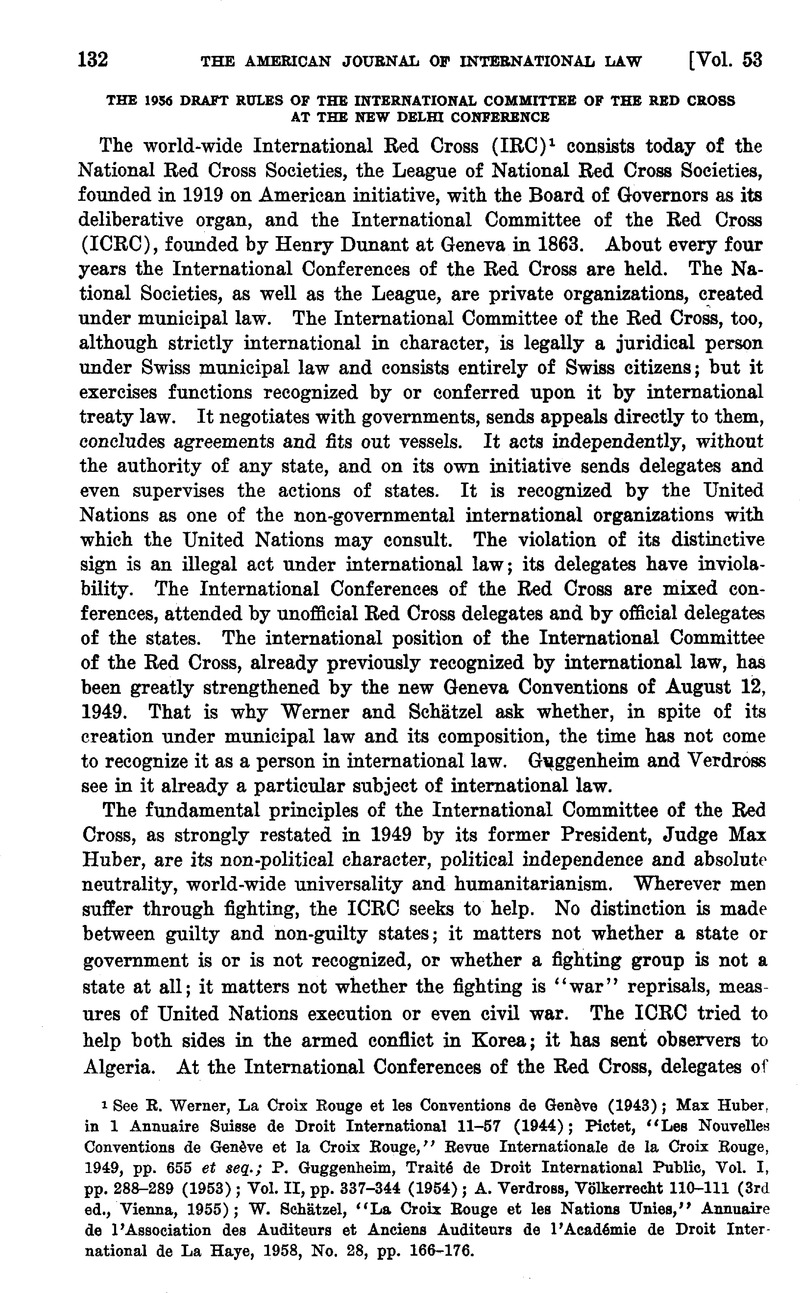No CrossRef data available.
Article contents
The 1956 Draft Rules of the International Committee of the Red Cross at the New Delhi Conference
Published online by Cambridge University Press: 28 March 2017
Abstract

- Type
- Editorial Comment
- Information
- Copyright
- Copyright © American Society of International Law 1959
References
1 See E. Werner, La Croix Rouge et les Conventions de Genève (1943) ; Max Huber, in 1 Annuaire Suisse de Droit International 11-57 (1944); Pictet, “Les Nouvelles Conventions de Genè ve et la Croix Eouge,” Eevue Internationale de la Croix Rouge, 1949, pp. 655 et seq.; P. Guggenheim, Traité de Droit International Public, Vol. I, pp. 288-289 (1953) ; Vol. II , pp. 337-344 (1954) ; A. Verdross, Völkerreeht 110-111 (3rd ed., Vienna, 1955); W. Schätzel, “La Croix Rouge et les Nations Unies,” Annuaire de 1'Association des Auditeurs et Anciens Auditeurs de l'Acadénie de Droit International de La Haye, 1958, No. 28, pp. 166-176.
2 The Geneva Conference of 1929 had previously recommended unanimously that a careful study be made in preparation for a convention concerning the protection of the civilian population. The idea of “security zones” appeared in 1929 and 1931. On Dec. 22, 1931, the ICEC sent its Circular No. 300, concerning the legal protection of the civilian population from the dangers of aerial and chemical warfare, to all the National Bed Cross Societies. The so-called “Tokyo Draft” on the same subject was submitted to the 15th International Conference of the Red Cross. A revised draft of the 1929 Conventions was considered by the 16th Conference (London, 1938). All these studies were submitted to the Swiss Government which had intended to convoke a diplomatic conference at Geneva in 1940.
3 See Josef L. Kunz, “The Geneva Conventions of August 12, 1949,” in Lipsky (ed.), Law and Politics in the World Community 279-316, 368-373 (University of California Press, 1953).
4 Arts. 35-46 apply only to protected civilian persons in the territory of a party to the conflict; Arts. 47-78 apply only to protected civilian persons in occupied territories; the “general protection” of the civilian population found no expression in rules of law.
5 Draft rules for the protection of the civilian population from the dangers of indiscriminate warfare. With commentary (ICEC, Geneva, June, 1955, mimeographed, 115 pp.).
6 On the Draft Rules, 1955, see Kunz, Josef L., “The Laws of War,” 50 A.J.I.L. 313-337, at 323-325 (1956).Google Scholar
7 The report on this meeting was published by the ICRC as Doc. No. 347b.
8 Published with commentary by the ICEC (Geneva, September, 1956, 168 pp.).
9 19th International Conference of the Bed Cross, New Delhi, October-November, 1957. Final Record concerning the Draft Rules for the limitation of dangers incurred by the civilian population in time of war (ICEC, Geneva, April, 1958, mimeographed, 184 pp.). Further quoted as Final Record.
10 We have already referred to the dividing line: “Geneva” and “Hague” laws of war. This writer has in his study (cited in note 6) pointed out the reasons why such a complete division is hardly possible. The Geneva Diplomatic Conference of 1949 continuously emphasized its lack of competence within the realm of the “Hague” laws of war; yet it is clear that such rules as the prohibition of reprisals, prohibition of taking hostages, prisoner-of-war status, under certain conditions, of members of resistance movements, even in occupied territories, profoundly influence the rules concerning the actual conduct of warfare. In 1955 the ICEC itself had stated that it had to go beyond the “Geneva” into the “Hague” laws of war, that the field covered by the 1955 Draft Rules is rather different from that covered by the Geneva Conventions. But the 1956 Draft Rules try to restrict themselves to the “Geneva” laws of war: hence the title of the corresponding Commission at the New Delhi Conference. The dividing line between “Geneva” and “Hague” laws of war was one of the arguments in the discussions.
11 Some countries were represented only by Red Cross, others only by governmental delegates; some had two different delegates; in some cases the same person acted in a dual capacity, as representative of the Bed Cross and of the government.
12 All Communist countries were represented; there were also delegates of the Federal Republic of Germany and of the “Democratic Republic of Germany,” of the Republic of Korea and of the ‘ ‘ Democratic Republic of Korea'’ and of North Viet-Nam.
13 U.S.S.R., Bulgaria, Hungary, Poland, North Korea, Rumania.
14 Argentina, Brazil, Belgium, Denmark, Ireland, Sweden. Uruguay proposed to hold a general debate first, followed by a discussion article by article. Chile proposed a general debate, followed by a discussion only of such articles on which there was no general agreement.
15 See List of Proposals and Amendments concerning the Draft Rules, Pinal Record 175-184.
16 Final Record 33-34.
17 Albania, China, Czechoslovakia, German Democratic Republic, Hungary, North “Viet-Nam, Poland, Rumania, U.S.S.R. The Yugoslav Delegation always took a completely independent stand. Burma and Syria took the same position as that taken by the Communist delegates. 18 Brazil, Final Record 20.
19 Peru, ibid. 25.
20 Austria, ibid. 43; Belgium, ibid. 34-35; Canada, ibid. 67-68; El Salvador, ibid. 77-78; Mexico, ibid. 40; Pakistan, ibid. 83-84.
21 Ibid. 21-22.
22 Ibid. 37-38. He also stated: “ I personally wish that atomic weapons had never been invented.
23 lbid. 44r-45.
24 Ibid. 47-48.
25 Ibid. 56-57.
26 Ibid. 29-37, 62-66. ‘ ‘ Do you believe that governments which possess atomic -weapons are convinced that the use of those weapons is a moral sin, a proof of wicked men! So far, I have seen no signs in this direction.” (p. 65.) “Can you believe that if a conflict should break out, and people's vital interests were at stake, that governments would hesitate, on moral grounds, to make use of such weapons? No.“ (p. 66.)
27 Ibid. 36-37.
28 Ibid. 112-113.
29 Ibid. 70-71.
30 Ibid. 113-115.




